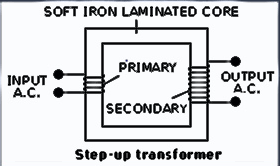 Short Answer Type
Short Answer TypeState the law of radioactive decay.
Plot a graph showing the number (N) of undecayed nuclei as a function of time (t) for a given radioactive sample having half-life T½.
Depict in the plot the number of undecayed nuclei at (i) t = 3 T½ and (ii) t = 5 T½. Long Answer Type
Long Answer Type(i) With the help of a labelled diagram, describe briefly the underlying principle and working of a step up transformer.
(ii) Write any two sources of energy loss in a transformer.
(iii) A step up transformer converts a low input voltage into a high output voltage.
Does it violate law of conservation of energy? Explain.
i) Underlying principle of a step-up transformer:
A transformer which increases the ac voltage is known as a step up transformer.
Working of step-up transformer is based on the principle of mutual inductance and it converts the alternating low voltage to alternating high voltage. The number of turns in the secondary coil is greater than the number of turns in the primary coil.

i) Underlying principle of a step-up transformer: A transformer which increases the ac voltage is known as a step up transformer.
Working of step-up transformer is based on the principle of mutual inductance and it converts the alternating low voltage to alternating high voltage. The number of turns in the secondary coil is greater than the number of turns in the primary coil.
Working: When an A.C source is connected to the ends of the primary coil, the current changes continuously in the primary coil. Hence, the magnetic flux which is linked with the secondary coil changes continuously. So, the emf which is developed across the secondary coil is same as that in the primary coil. The emf is induced in the coil as per Faraday’s law.
Assumption: We assume that there is no leakage of flux so that, the flux linked with each turn of primary coil is same as flux linked with secondary coil.
ii) Two sources of energy loss in the transformer:
Joule Heating – Energy is lost in resistance of primary and secondary windings in the form of heat.
H = I2 Rt
Flux leakage - Energy is lost due to coupling of primary and secondary coils not being perfect, i.e., whole of magnetic flux generated in primary coil is not linked with the secondary coil.
iii) Conservation of law of energy is not violated in step-up transformer. When output voltage increases, the output current automatically decreases. Thus, there is no loss of energy.
Derive an expression for the impedance of a series LCR circuit connected to an AC supply of variable frequency.
Plot a graph showing variation of current with the frequency of the applied voltage.
Explain briefly how the phenomenon of resonance in the circuit can be used in the
Tuning mechanism of a radio or a TV set.(a) Draw a ray diagram to show refraction of a ray of monochromatic light passing through a glass prism.
Deduce the expression for the refractive index of glass in terms of angle of prism and angle of minimum deviation.
(b) Explain briefly how the phenomenon of total internal reflection is used in fiber optics.
(a) Obtain lens makers formula using the expression

Here the ray of light propagating from a rarer medium of refractive index (n1) to a denser medium of refractive index (n2) is incident on the convex side of spherical refracting surface of radius of curvature R.
(b) Draw a ray diagram to show the image formation by a concave mirror when the object is kept between its focus and the pole. Using this diagram, derive the magnification formula for the image formed.
